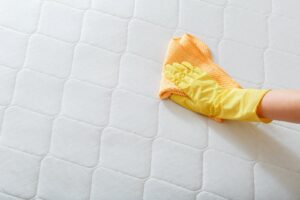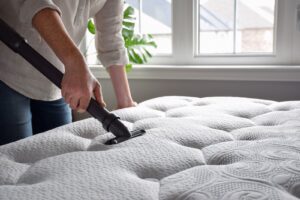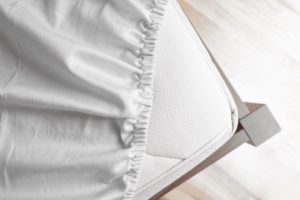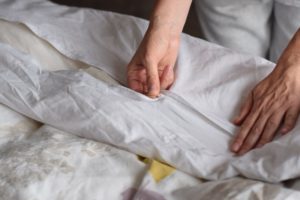| What It Is | Pros | Cons | |
|---|---|---|---|
| Coverlets | A thin, lightweight bed cover that can be used alone or combined with other bedding |
|
|
| Quilts | A three-layer bed cover, made by stitching a thin layer of batting between two layers of fabric |
|
|
| Duvets | Primary bedding consisting of an insert, often filled with real or synthetic down, enclosed by a cover |
|
|
| Comforters | A thick bed cover, made from two layers of fabric stuffed with a fluffy material, such as synthetic batting, cotton, down, or wool |
|
|
What Is a Coverlet?
Easy-Breezy Bedding
A coverlet is a thin, lightweight bed cover that offers visual appeal without being overly hot or heavy. Many people prize coverlets for their versatility, as there are several ways to use and style them. They also come in an array of materials, textures, and patterns, so if you want a coverlet, you should be able to find one that suits your taste.
Coverlets: Explained
Coverlets typically are made from a single layer of fabric, though they sometimes have two layers. Traditionally, coverlets were made using a French weaving technique called matelassé, which creates patterns and textures that mimic quilting but produce lighter, airier bedding. Coverlets are usually smaller than bedspreads but larger than throw blankets.
Depending on the season and your needs as a sleeper, there are a few ways to work a coverlet into your bedding. In warmer months, or if you sleep hot, you can use a coverlet instead of a quilt or comforter. In cooler months, or if you sleep cold, you can layer your coverlet between your top sheet and heavier bedding. You can also fold and drape it across the foot of your bed like a throw blanket for warmth and style.
Types of Coverlets
Generally, coverlets are made from natural fibers known for their cooling properties. Cotton, the most common coverlet material, is soft, durable, and breathable. Cotton coverlets come in a variety of styles, from classic waffle weaves to intricately stitched sateen fabric.
Another common coverlet fabric is linen, which has a loose weave that promotes airflow. Made from the fibers of the flax plant, linen wrinkles easily and has a distinct texture that has a rustic look. While linen can feel rough against skin at first, it softens with every wash.
Coverlets vs. Other Bedding: What’s the Difference?
With so many bedding options available, it can be hard to figure out which one is right for you. Knowing how to distinguish coverlets from other common bed covers can help you decide which bedding will meet your needs.
Scroll L – R for more details
Is a Coverlet Right For Your Bed?
Anyone can enjoy a coverlet for both its appearance and function at any time, but this type of bed cover makes especially good summer bedding. And for people who sleep hot or live in tropical climates, coverlets can be a great bedding choice throughout the year. Additionally, coverlets are an inexpensive way to add aesthetic appeal or to change the look of a bedroom.
While coverlets are very versatile, they do not offer much warmth when used as primary bedding. Consider pairing your coverlet with a duvet or quilt if you’re a cold sleeper or need additional warmth when it’s cold outside.
How to Wash a Coverlet
How you use your coverlet will determine how often you need to wash it. If you are using it as your primary bed cover, you should clean it every one to four weeks, as you would a duvet cover. If you are using it as a blanket between layers of bedding or at the foot of your bed, wash it once or twice each month.
Before laundering your coverlet, read the tag for instructions. Many coverlets can be machine-washed like a blanket. Using the gentle cycle and cold water may help extend the life of your coverlet and preserve its colors.
Some coverlets can be machine-dried on low heat, while others should be line dried to avoid shrinking or pilling.

Still have questions? Ask our community!
Join our Sleep Care Community — a trusted hub of sleep health professionals, product specialists, and people just like you. Whether you need expert sleep advice for your insomnia or you’re searching for the perfect mattress, we’ve got you covered. Get personalized guidance from the experts who know sleep best.









